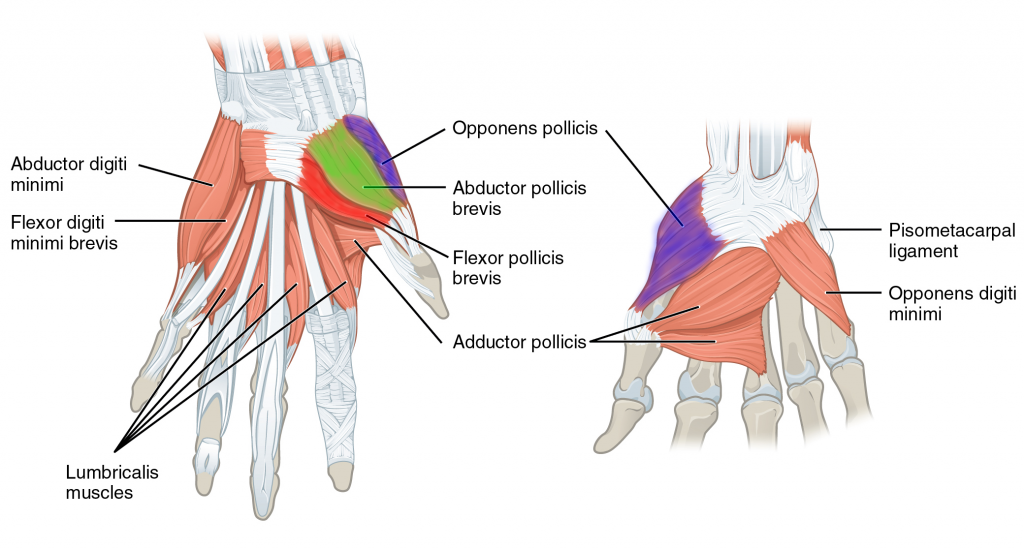
Anatomy
This was previously featured in an exam
This was previously featured in an exam
Upper Limb
Question 11 of 30
You have been asked to review a 32 year old pastry chef. She sustained a laceration to her left thenar eminence whilst working. Which of the following muscles is part of the thenar eminence:
Answer:
The thenar eminence consists of the opponens pollicis, the abductor pollicis brevis and the flexor pollicis brevis. The adductor pollicis is an intrinsic hand muscle, but not part of the thenar eminence. The extensor pollicis longus and brevis, and the abductor pollicis longus are found in the posterior forearm.Thenar Muscles
Anatomy / Upper Limb / Wrist and Hand
Last Updated: 10th April 2019
The thenar eminence consists of the opponens pollicis, the abductor pollicis brevis and the flexor pollicis brevis muscles.
The thenar muscles are all innervated by the median nerve.

Thenar Eminence. (Image modified by FRCEM Success. Original by OpenStax [CC BY 4.0 , via Wikimedia Commons)
Function
Table: Function and Innervation of the Thenar Muscles
| Muscle | Function | Innervation |
|---|---|---|
| Opponens pollicis | Medially rotates thumb | Median nerve |
| Abductor pollicis brevis | Abducts thumb at MCPJ | Median nerve |
| Flexor pollicis brevis | Flexes thumb at MCPJ | Median nerve |
Report A Problem
Is there something wrong with this question? Let us know and we’ll fix it as soon as possible.
Loading Form...
- Biochemistry
- Blood Gases
- Haematology
| Biochemistry | Normal Value |
|---|---|
| Sodium | 135 – 145 mmol/l |
| Potassium | 3.0 – 4.5 mmol/l |
| Urea | 2.5 – 7.5 mmol/l |
| Glucose | 3.5 – 5.0 mmol/l |
| Creatinine | 35 – 135 μmol/l |
| Alanine Aminotransferase (ALT) | 5 – 35 U/l |
| Gamma-glutamyl Transferase (GGT) | < 65 U/l |
| Alkaline Phosphatase (ALP) | 30 – 135 U/l |
| Aspartate Aminotransferase (AST) | < 40 U/l |
| Total Protein | 60 – 80 g/l |
| Albumin | 35 – 50 g/l |
| Globulin | 2.4 – 3.5 g/dl |
| Amylase | < 70 U/l |
| Total Bilirubin | 3 – 17 μmol/l |
| Calcium | 2.1 – 2.5 mmol/l |
| Chloride | 95 – 105 mmol/l |
| Phosphate | 0.8 – 1.4 mmol/l |
| Haematology | Normal Value |
|---|---|
| Haemoglobin | 11.5 – 16.6 g/dl |
| White Blood Cells | 4.0 – 11.0 x 109/l |
| Platelets | 150 – 450 x 109/l |
| MCV | 80 – 96 fl |
| MCHC | 32 – 36 g/dl |
| Neutrophils | 2.0 – 7.5 x 109/l |
| Lymphocytes | 1.5 – 4.0 x 109/l |
| Monocytes | 0.3 – 1.0 x 109/l |
| Eosinophils | 0.1 – 0.5 x 109/l |
| Basophils | < 0.2 x 109/l |
| Reticulocytes | < 2% |
| Haematocrit | 0.35 – 0.49 |
| Red Cell Distribution Width | 11 – 15% |
| Blood Gases | Normal Value |
|---|---|
| pH | 7.35 – 7.45 |
| pO2 | 11 – 14 kPa |
| pCO2 | 4.5 – 6.0 kPa |
| Base Excess | -2 – +2 mmol/l |
| Bicarbonate | 24 – 30 mmol/l |
| Lactate | < 2 mmol/l |

